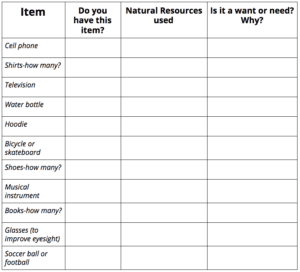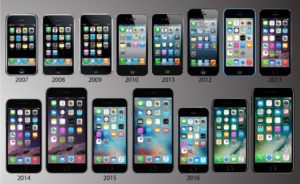In a world teeming with 7.7 BILLION people how we use, distribute, and care for the earth’s natural resources matters. All the stuff we buy impacts the earth, from extraction to disposal. Remember that the raw materials for everything we use and consume comes from the earth! Can you name some natural resources?
So here’s how America is doing:
The United States makes up roughly 5% of the world’s population, yet consumes 25% of the world’s resources.
Let’s break this down even more. According to an article published in Scientific American, David Tilford of the Sierra Club stated “With less than 5 percent of world population, the U.S. uses one-third of the world’s paper, a quarter of the world’s oil, 23 percent of the coal, 27 percent of the aluminum, and 19 percent of the copper,” he reports. “Our per capita use of energy, metals, minerals, forest products, fish, grains, meat, and even freshwater dwarfs that of people living in the developing world.” The percentage of waste created is similarly disheartening: Americans create an estimated 30% of the world’s waste. We aren’t the only developed country taking more than our fair share, but we could do better.
Watch this video about (over) consumption.

These are some natural resources we use:
- Water
- Timber
- Coal
- Oil
- Phosphorous
- Iron
- Natural gas
- Bauxite
- Soil
- Silica
- Limestone
- Sun
- Wind
- Copper
For a deeper look into renewable and non-renewable energy sources, check out this lesson.
The clothes we wear, the devices we use, the packaging our products are wrapped in, the food we eat, the homes we live in, the books we read, the chair we are sitting on, and everything we buy, is made from raw materials extracted from the earth.
What were the last 3 things you purchased, not including food? What were the resources used to make the products you purchased?
Humans need food, shelter, water, air, and clothing to survive. And, of course, we buy other things that make our lives easier and more fun. But Americans tend to love shopping and as a result, use vast amounts of resources, accumulate a lot of stuff, and subsequently create more waste bound for landfills. The holiday season, in particular, is a shopping frenzy that begins just after Halloween with sales, deals, and more sales often causing people to go into debt.
It’s a balancing act between wants and needs. Yes, we all need clothes to protect us from the elements, but do we need a closet full? How do you balance wants vs needs?
Let’s look at some material goods we might have. Answer the three questions after each item as best you can.

Share with your friends and family and compare the answers for whether an item is a want or a need. How do you decide what to buy? For example, when I feel the strong urge to buy something I might wait a week. Often if I wait at least a few days, I no longer really want to buy it. Think before you buy.
Why do we buy so much?
- Peer pressure
- Advertising
- Impulse buy
- Think it will make us happy

We want to have the same things as our friends have. We want to fit in. Advertising plays a huge role in the selling of products to consumers. It seems someone is always trying to sell us something. Sometimes we impulse buy to make us feel better after a bad day. And we buy things because we think things will make us happy. Maybe it will for a few minutes or a day, but ultimately having more stuff does not bring happiness and it definitely isn’t better for the environment.
Corporations and companies play a part in our consumer habits in conjunction with advertising in a couple of ways:
- Perceived obsolescence. Customers believe they need to buy a new upgraded product even though the older model still works fine. Again, the example of the cell phone. Every year a new version is presented to the consumer and the company encourages us to buy this updated, better, faster phone.

- Planned obsolescence. When a product is deliberately designed to have a shorter life span. An example of this that most of us can relate to is the battery life of a cell phone or the phone’s inability to work as well after a software update. Basically, the product is designed in a way that encourages the consumer to buy the product over and over instead of focusing on building a quality product that will last years if not decades.

Both of these tactics negatively impact the environment because more resources are used in manufacturing more products and because more waste is created that will sit around in a landfill for hundreds of years. These factories are often in developing countries with no minimum wage or protections for workers who labor 7 days a week for meager pay. Interested in learning about how paper and glass are made? Check out the lesson on the life cycle of paper and the life cycle of glass.
It’s simply not sustainable to continue consuming at our current rate.
Here are some ways to be a smarter consumer:
- Buy less
- Buy used
- Buy locally made or grown
- Repair
- Learn to sew or knit
- Buy quality products that are built to last
What are other ideas you have?
Stay tuned, next week in Material World part II we will look at fast fashion and the impacts of clothing on the environment and society! See you then.
Take Action
Discover the life cycle of stuff!

Continue learning
There are lots of topics for you to choose from. Don’t stop here; move on to discover another lesson! New lessons uploaded each week.


